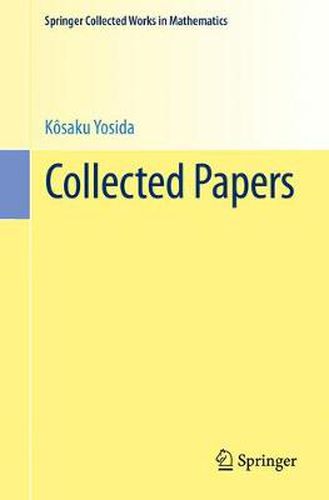Readings Newsletter
Become a Readings Member to make your shopping experience even easier.
Sign in or sign up for free!
You’re not far away from qualifying for FREE standard shipping within Australia
You’ve qualified for FREE standard shipping within Australia
The cart is loading…






This title is printed to order. This book may have been self-published. If so, we cannot guarantee the quality of the content. In the main most books will have gone through the editing process however some may not. We therefore suggest that you be aware of this before ordering this book. If in doubt check either the author or publisher’s details as we are unable to accept any returns unless they are faulty. Please contact us if you have any questions.
Kosaku Yosida, born on February 7, 1909, was brought up in Tokyo. Having majored in Mathematics at University of Tokyo, he was appointed to Assistant at Osaka University in 1933 and promoted to Associate Professor in 1934. He re ceived the title of Doctor of Science from Osaka University in 1939. In 1942 he was appointed to Professor at Nagoya University, where he worked very hard with his colleagues to promote and expand the newly established Department of Mathe matics. He was appointed to Professor at Osaka University in 1953 and then to Professor at University of Tokyo in 1955. After retiring from University of Tokyo in 1969, he was appointed to Professor at Kyoto University, where he also acted as Director of the Research Institute for Mathematical Sciences. He retired from Kyoto University in 1972 and worked as Professor at Gakushuin University until 1979. Yosida acted as President of the Mathematical Society of Japan, as Member of the Science Council of Japan, and as Member of the Executive Committee of the International Mathematical Union. In 1967 he received the Japan Academy Prize and the Imperial Prize for his famous work on the theory of semigroups and its applications. In 1971 he was elected Member of the Japan Academy. Yosida went abroad many times to give series of lectures at mathematical in stitutions and to deliver invited lectures at international mathematical symposia.
$9.00 standard shipping within Australia
FREE standard shipping within Australia for orders over $100.00
Express & International shipping calculated at checkout
This title is printed to order. This book may have been self-published. If so, we cannot guarantee the quality of the content. In the main most books will have gone through the editing process however some may not. We therefore suggest that you be aware of this before ordering this book. If in doubt check either the author or publisher’s details as we are unable to accept any returns unless they are faulty. Please contact us if you have any questions.
Kosaku Yosida, born on February 7, 1909, was brought up in Tokyo. Having majored in Mathematics at University of Tokyo, he was appointed to Assistant at Osaka University in 1933 and promoted to Associate Professor in 1934. He re ceived the title of Doctor of Science from Osaka University in 1939. In 1942 he was appointed to Professor at Nagoya University, where he worked very hard with his colleagues to promote and expand the newly established Department of Mathe matics. He was appointed to Professor at Osaka University in 1953 and then to Professor at University of Tokyo in 1955. After retiring from University of Tokyo in 1969, he was appointed to Professor at Kyoto University, where he also acted as Director of the Research Institute for Mathematical Sciences. He retired from Kyoto University in 1972 and worked as Professor at Gakushuin University until 1979. Yosida acted as President of the Mathematical Society of Japan, as Member of the Science Council of Japan, and as Member of the Executive Committee of the International Mathematical Union. In 1967 he received the Japan Academy Prize and the Imperial Prize for his famous work on the theory of semigroups and its applications. In 1971 he was elected Member of the Japan Academy. Yosida went abroad many times to give series of lectures at mathematical in stitutions and to deliver invited lectures at international mathematical symposia.